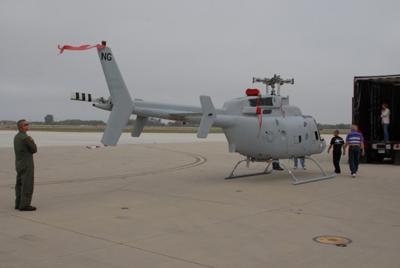Utilized Mobile Mission Control Station For The First Time
The "Wildcards" of Helicopter Sea Combat Squadron (HSC) 23 made history this month, operating MQ-8B Fire Scout Unmanned Air Vehicles (UAV) from Naval Auxiliary Landing Field (NALF) San Clemente Island utilizing a Mobile Mission Control Station (MMCS).

Teams of pilots, aircrewmen, maintenance personnel and civilian specialists functioned organically to complete integrated missions with various surface and air assets.
The two-week operation culminated with the successful employment of the Fire Scout as the laser designating platform for an AGM-114N Hellfire missile, fired from an MH-60S Knighthawk attached to HSC-23 Detachment 2 on board America-class amphibious assault ship USS America (LHA 6). Additionally, the team accomplished the first ever long-range transit of the Fire Scout by an operational squadron, executing a "control station handoff" while transiting between NALF San Clemente Island and Naval Base Ventura County (NBVC) Pt. Mugu. This operation has paved the way for the future development of the Fire Scout program, functioning as a force multiplier for the larger naval surface community and the tactical application of integrated manned and unmanned platforms in Naval Aviation.
Personnel from HSC-23 began operations from NALF San Clemente Island on May 3.
Prior to this detachment, Fire Scout operators conducted all flight training at NBVC Pt. Mugu, which is approximately 175 miles northwest of San Diego. Bringing the system to NALF San Clemente Island, which is located 80 miles west of San Diego, afforded many opportunities for integrated training with naval assets due to the multitude of ranges and support facilities around the island. The detachment planned and coordinated events despite an array of logistical hurdles, and established procedures for unmanned air vehicle operations within San Clemente Island airspace. "A primary goal for this detachment was to showcase the capabilities of the MQ-8B," said Lt. Cmdr. David Barnhill, officer-in-charge of the detachment. "San Clemente Island broadens the training opportunities for our Fire Scout team and gives us the ability to work with a multitude of assets not otherwise available."
After completing unit-level training and confidence testing of the Fire Scout system within local and special use airspace during the first week, Fire Scout crewmembers flew range clearance missions and a successful Hellfire missile event in support of USS America Amphibious Ready Group (ARG) on May 10. "The Hellfire shot was absolutely a highlight for this detachment. It proved that Fire Scout is a viable asset to an already potent team," continued Barnhill. "But more than that, executing a successful in-flight transfer of the MQ-8B from one air vehicle operator to another over 70 miles away was the biggest milestone. It gives us enormous operational flexibility going forward to work with fleet elements on a regular basis."
This detachment can be classified as a resounding success by bringing UAV operations to the fleet on a larger scale than ever before. The Fire Scout provides critical mission sets to enhance battlespace awareness as well as providing early warning detection and classification capability. HSC-23 is at the forefront of MQ-8B Fire Scout operations, driving the development and refinement of manned/unmanned tactics and providing a clear path for the future of Fire Scout operators.
HSC-23 "Wildcards" are a Coronado-based expeditionary squadron under Commander, Helicopter Sea Combat Wing Pacific. It is the first squadron to deploy a MH-60S and MQ-8B composite detachment aboard an Independence-class littoral combat ship.
(Source: U.S. Navy news release. Image from file)
 NTSB Final Report: Evektor-Aerotechnik A S Harmony LSA
NTSB Final Report: Evektor-Aerotechnik A S Harmony LSA ANN's Daily Aero-Term (09.15.25): Decision Altitude (DA)
ANN's Daily Aero-Term (09.15.25): Decision Altitude (DA) Aero-News: Quote of the Day (09.15.25)
Aero-News: Quote of the Day (09.15.25) Airborne 09.12.25: Bristell Cert, Jetson ONE Delivery, GAMA Sales Report
Airborne 09.12.25: Bristell Cert, Jetson ONE Delivery, GAMA Sales Report Airborne 09.10.25: 1000 Hr B29 Pilot, Airplane Pile-Up, Haitian Restrictions
Airborne 09.10.25: 1000 Hr B29 Pilot, Airplane Pile-Up, Haitian Restrictions



